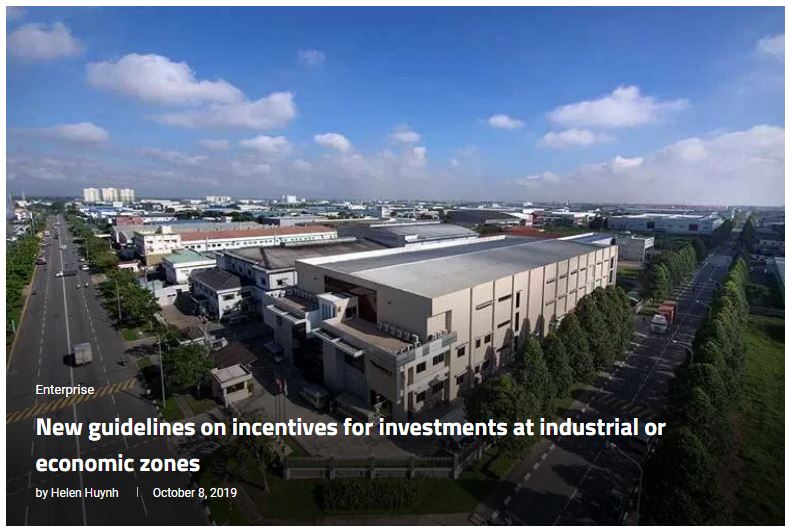Vietnam: New guidelines on incentives for investments at industrial or economic zones
In August, the Ministry of Finance issued Circular No. 43/2019/TT-BTC (“the Circular”), passing new guidelines on incentives for investments at industrial or economic zones stated in Decree No. 82/2018 / ND-CP. The reform took effect on August 26, 2019.
The Circular provides details on tax incentives for enterprises that have investment projects in Vietnam’s industrial and economic zones, encouraging them to make investments that improve the quality of life around industrial zones.
Specifically, the new incentives apply to the construction, operation, or renting of condominium apartments as well as investment into infrastructure that can develop like cultural, medical, and sports centers for employees of these industrial and economic and zones.
Income tax incentives
In order to cover a company’s expenses incurred in investments for workers’ facilities, businesses can now enjoy a reduction in their taxable income in two ways.
Value of fixed assets
The value of fixed assets may be aggregated by the construction cost of these facilities. Over time, the depreciation cost of these assets can be deducted through deductible expenses calculations when determining corporate income tax.
Other Expenses
Expenses other than the above can be accounted into the deductible expenses upon taxable income calculation as prescribed in the law on corporate income tax.
Why invest in IZ housing development
Vietnam’s industrial and economic zones are the driving force of the country’s economic industrialization and modernization progress, pushing up employment rates and income levels. However, the lack of housing and facilities for workers at industrial zones has emerged as a major challenge for workers, employers, and the government.
The Circular’s new incentives aim to address this challenge.
Housing shortages in industrial zones
More than 50 percent of the workers at these industrial zones are migrant workers. Yet, according to a 2016 survey conducted by Vietnam General Confederation of Labour, only 1.5 of the 2.7 million workers working at 344 of the country’s industrial zones had their housing demands met.
Opportunities
As more and more workers move into these industrial zones from neighboring areas, there are significant opportunities that real estate developers and investors can look to seize.
Investors with investment projects in comparatively less developed regions of Vietnam – such as the central region – may benefit from investing in housing infrastructure for workers, especially because these regions find it difficult to attract the right workers there. Qualified workers – like those in technical fields – often find better opportunities in the north and the south, making it challenging for enterprises in the central region to hire and retain highly skilled migrant workers.
More generally, however, companies that understand their regions and employee’s needs have already started investing in the construction of housing and other facilities for their employees.
For example, South Korean conglomerate Samsung – which has over 100,000 employees working across its manufacturing facilities in the Yen Phong industrial zone in Bac Ninh and Thai Nguyen provinces – invests and provides modern housing and amenities for its workers. These include dormitories with facilities like cinema, welfare rooms, a supermarket, a hair salon, a yoga room, and a gym.
Vietnam’s industrial zones
Businesses that invest in worker facilities will find that it goes a long way in retaining and attracting talent while remaining competitive.
As more and more companies move to Vietnam, competition for talent has also increased. With Vietnam challenging China as a destination for export manufacturing, incentives such as the Circular ensures that investors will have further incentive to make a sustainable, long-term investment in Vietnam.
As of now, the country as a total of 8,970 FDI projects, with a total registered capital of US$187.4 billion in these industrial and economic zones. These industrial zones are also proving to be an attraction for domestic investment projects: they are home to a total of 9,140 local investment projects, with a total registered capital of more than US$89.2 billion.
According to the latest report from the Department of Economic Zone Management at the Ministry of Planning and Investment, industrial and economic zones in Vietnam attracted 397 FDI projects with an estimated registered capital of US$10.1 billion in the first nine months of this year. Domestically, the zones attracted 388 new domestic projects with a total newly registered capital of US$4.1 billion in the first nine months.
Ultimately, Vietnam’s industrial zones play an important role in attracting foreign direct investments into the country. The industrial zones, in general, offer a wealth of advantages for investors in Vietnam like various personal and corporate income tax incentives, better infrastructure, and streamlined compliance requirements.
Source: Vietnam-briefing
Source: https://vietnaminsider.vn/new-guidelines-on-incentives-for-investments-in-at-industrial-or-economic-zones/


 Thailand
Thailand




